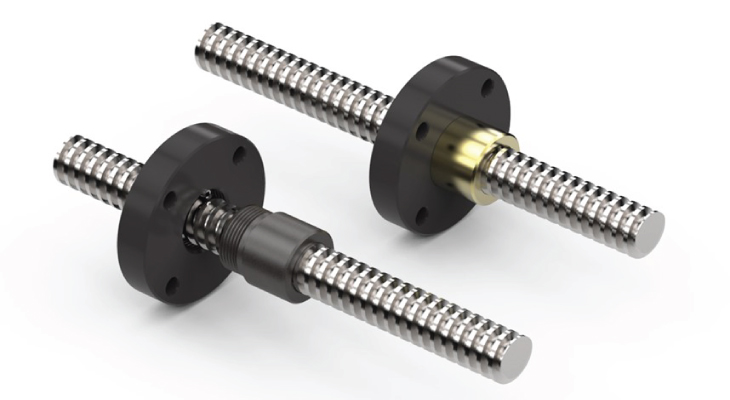How Plastic Acme Nuts Can Fix Acme Screw Challenges

While lead screws provide cost, performance, and dependability advantages for many of today’s linear actuation requirements, some motion control applications present challenges that require the use of plastic acme nuts. These are engineered to provide internal lubrication and make lead screws operate more smoothly, quietly, and reliably.
Lead screws utilize the helix angle of the screw thread to convert rotary motion into linear motion and rely on the coefficient of friction between the nut and screw to position loads. The acme thread form—the original trapezoidal screw thread—has a 29° thread angle with a thread height half the pitch. Because the tooth shape of an acme thread has a broader base, it is more vital than a similarly sized square thread and capable of carrying larger loads.
Acme screws are available in various materials, such as carbon steel and stainless steel. They can be paired with a bearing-grade bronze or internally lubricated plastic acme lead nut. This article will examine the operating conditions that require the use of lubricated plastic acme and lead nuts.
Why Lead Screws Require Lubrication
In the past, many design engineers believed that the characteristics inherent to lead screws made them unsuitable for high-temperature, high-load, or high-duty-cycle applications, often opting instead for costly ball screws for these types of applications. Or, if they did use acme screws, they would require frequent lubrication and maintenance to counteract frictional effects. However, a new generation of lead screws is made from engineered plastics and polymers that reduce friction—and the heat, noise, and wear it creates—with built-in, internal lubrication. Making the combination of a lead screw and plastic acme lead nut a viable, more cost-effective option.
Acme screws utilize friction to convert rotary motion into linear motion. Their operation can create heat, noise, and wear. These characteristics present additional performance challenges in applications that operate in high-temperature environments, position heavy loads or perform high-duty cycles. Examples of these operating conditions include rapid prototyping machines that utilize liquid plastics at high ambient temperatures; factory automation systems that repeatedly move heavy loads; and lighting systems that frequently move under the heat generated by powerful lights.
Reasons to Invest in Plastic Screws
One of the benefits of lead screw assemblies is how easily they can be customized. Engineers have the option of working with a variety of materials from stainless steel, alloy steel, aluminum, titanium, and bronze. The manufacturing methods range from rolled, ground, machined...and molded?
Did you know that one of the options for creating a lead screw is plastic?
Plastic may not be the most popular material for lead screws, but it has great potential applications. For the right conditions, it may be the best solution. One of the areas to use them is in medical device manufacturing. Metered insulin pens use tiny, plastic lead screws to deliver accurate doses of medicine to diabetic patients. The plastic lead screws in the pen are recyclable and environmentally friendly, lightweight, and low cost. Custom screw and nut designs are possible for special features, meeting small space constraints, compatible materials, and accuracy.
Advanced Materials for Acme Nuts
A range of advanced nut materials has been developed, including custom-engineered polymers, which integrate lead screw technology into applications that previously would not have been possible. Helix acme lead nuts are available in several types of plastics, including PEEK, polyester, acetal, Torlon®, Vespel®, PVDF, UHMW, and Ertalyte®, as well as customer-supplied specialty materials.
Various plastic types for nuts are necessary because of varying pressure velocity (PV) and thermoplastic characteristics. For example, while an acetal plastic blended with 15 percent PTFE lubricant is cost-effective for lighter loads, its PV value—a measure of a material’s ability to be dynamically loaded—is insufficient to support higher loads without overheating and deforming. Blends of Torlon, Vespel, and PEEK might have higher PV values that, when blended with PTFE lubricant form bearing-grade materials that are much better suited for higher temperatures and heavy loads.
Choose Helix Linear for Acme Nuts Made from Engineered Materials
When your application presents linear actuation challenges—whether related to the operating environment, load, or duty cycle—Helix Linear Technologies can provide an effective, affordable solution. By combining lead screws with Acme nuts made from custom-engineered materials, HELIX Linear can develop lead screw configurations that resolve performance challenges related to heat, stress, and wear—enabling you to take advantage of cost-effective lead screws for applications that heretofore were not possible.


